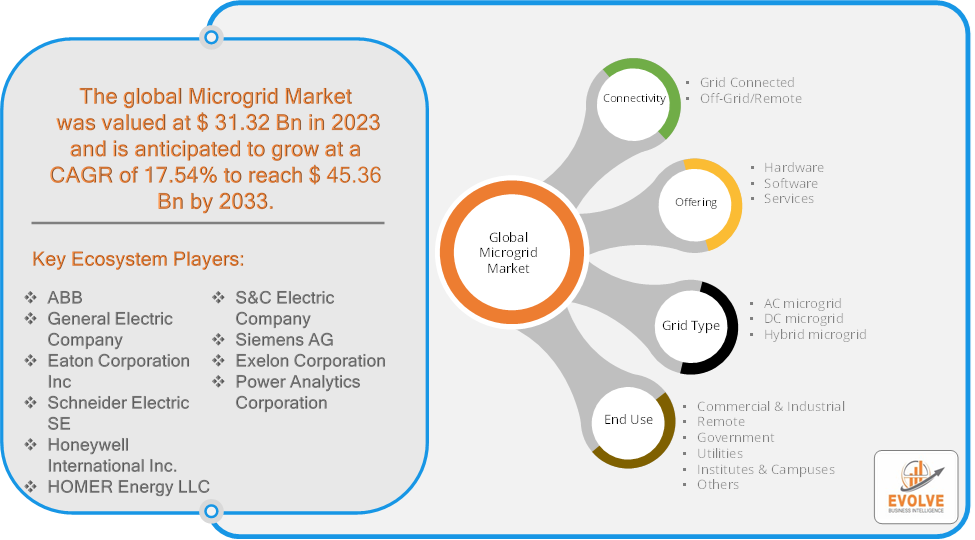Evolve Business Intelligence has published a research report on the Global Microgrid Market, 2023–2033. The global Microgrid Market is projected to exhibit a CAGR of around 17.54% during the forecast period of 2023 to 2033.
Evolve Business Intelligence has recognized the following companies as the key players in the global Microgrid Market: ABB, General Electric Company, Eaton Corporation Inc, Schneider Electric SE, Honeywell International Inc., HOMER Energy LLC, S&C Electric Company, Siemens AG, Exelon Corporation and Power Analytics Corporation.
 More Information: https://evolvebi.com/report/microgrid-market-analysis/
More Information: https://evolvebi.com/report/microgrid-market-analysis/
Market Highlights
The Global Microgrid Market is projected to be valued at USD 45.36 Billion by 2033, recording a CAGR of around 17.54% during the forecast period. The Microgrid Market refers to the industry cantered around the development, implementation, and management of microgrids. A microgrid is a localized energy system that can operate independently or in conjunction with the main power grid. It typically includes distributed energy resources (such as solar panels, wind turbines, and battery storage), control systems, and loads (such as homes, businesses, and other facilities).
The microgrid market is expanding as organizations and communities seek to enhance energy reliability, sustainability, and independence. The market is driven by factors such as the increasing demand for reliable and resilient power supply, the growing emphasis on renewable energy integration, government incentives and regulations promoting clean energy, and advancements in microgrid technologies.
The COVID-19 pandemic had a significant impact on the Microgrid Market. The pandemic caused disruptions in global supply chains, leading to delays in the delivery of components such as solar panels, batteries, and control systems. This affected the timeline for microgrid projects. Lockdowns and restrictions hindered on-site work, causing delays in the construction and commissioning of new microgrid projects. The pandemic highlighted the need for reliable and resilient energy systems, driving increased interest in microgrids as a solution for ensuring continuous power supply, especially in critical infrastructure like hospitals and data centers. As remote work and online activities surged, there was a greater emphasis on ensuring reliable power in off-grid and remote areas, boosting the demand for microgrids. The pandemic reinforced the importance of sustainability and the transition to renewable energy sources. Microgrids, often integrating solar, wind, and other renewables, align well with these goals. The shift towards remote monitoring and control of energy systems accelerated the adoption of digital solutions and smart technologies within microgrids, enhancing their efficiency and management. The pandemic spurred innovation in microgrid technology, with a focus on improving resilience, scalability, and integration with other energy systems.
Segmental Analysis
The global Microgrid Market has been segmented based on Connectivity, Offering, Grid Type and End Use.
Based on Connectivity, the Microgrid Market is segmented into Grid Connected and Off-Grid/Remote. The Grid Connected segment is anticipated to dominate the market.
Based on Offering, the global Microgrid Market has been divided into Hardware, Software & Services. The Hardware segment is anticipated to dominate the market.
Based on Grid Type, the global Microgrid Market has been divided into AC microgrid, DC microgrid and Hybrid microgrid. The DC microgrid segment is anticipated to dominate the market.
Based on End Use, the global Microgrid Market has been divided into Commercial & Industrial, Remote, Government, Utilities, Institutes & Campuses and Others. The Commercial & Industrial segment is anticipated to dominate the market.
More Information: https://evolvebi.com/report/microgrid-market-analysis/
Regional Analysis
The Microgrid Market is divided into five regions: North America, Europe, Asia-Pacific, South America, and the Middle East, & Africa. In North America region, the U.S. has a well-developed microgrid market, driven by factors such as energy resilience, sustainability goals, and government incentives. Key applications include military bases, universities, and critical infrastructure. States like California and New York are leading in microgrid adoption due to their focus on renewable energy and grid reliability. In Europe region, Countries like Germany, the United Kingdom, and France are at the forefront of microgrid development in Europe. The market is driven by strong regulatory support for renewable energy, energy efficiency goals, and the need for grid modernization. European microgrids often focus on integrating distributed energy resources and enhancing energy resilience. In Asia-Pacific region, India presents significant opportunities for microgrid development, particularly in rural and off-grid areas. Government initiatives and funding programs support the deployment of microgrids to provide reliable electricity and enhance energy access. In Latin America region, Brazil is exploring microgrid solutions to support remote communities and improve energy reliability. The market is driven by the need to address energy access issues and integrate renewable energy sources. In Middle east and Africa region, Countries like the United Arab Emirates and Saudi Arabia are developing microgrids to support their ambitions for renewable energy and sustainable development. Microgrids are also being used in remote areas and for critical infrastructure.